MA611 Auditing: Financial Statement Analysis of Blackmores Limited
VerifiedAdded on 2023/06/04
|14
|3515
|120
Report
AI Summary
This report provides an in-depth financial reporting analysis of Blackmores Limited, focusing on the application of auditing principles and processes. It examines analytical procedures, including simple comparisons and ratio analysis (profitability, liquidity, financial leverage, efficiency, and market value), to assess the company's financial performance over three years. The report identifies inherent risks at the financial reporting level, considering factors such as management integrity, director experience, unusual pressures, the nature of Blackmores' business, and industry influences. It also addresses the risk of material misstatement at the assertion level, providing insights into account balances, validity of risks, substantive audit procedures, and internal controls. The analysis reveals fluctuations in profitability and efficiency ratios, coupled with a dependency on long-term borrowings, which could negatively impact audit assessments. The report concludes by highlighting key considerations for auditors based on the financial analysis and risk assessments, with the complete assignment available on Desklib, where students can find a wealth of solved assignments and study resources.
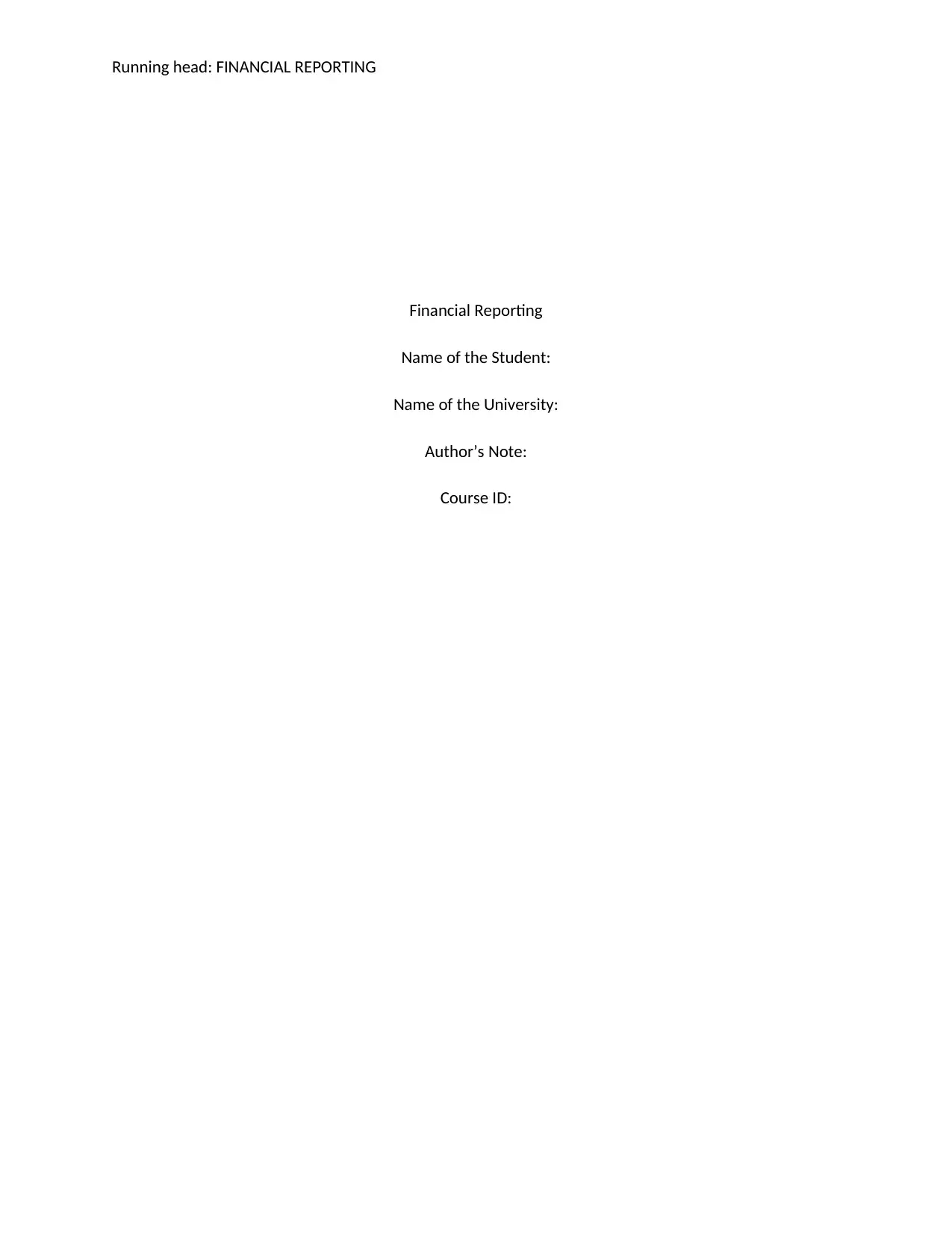
Running head: FINANCIAL REPORTING
Financial Reporting
Name of the Student:
Name of the University:
Author’s Note:
Course ID:
Financial Reporting
Name of the Student:
Name of the University:
Author’s Note:
Course ID:
Paraphrase This Document
Need a fresh take? Get an instant paraphrase of this document with our AI Paraphraser

1
FINANCIAL REPORTING
Executive Summary
The study shows understanding of different types of principles, practices and processes relating to
auditing of practical situations. The important discourse of the study has identified the results of
analytical procedures for Blackmore’s limited. In addition to this, some of the other discussions have
included the risk of material misstatement or the different types of inherent risk present at financial
reporting level for Blackmore’s limited. This section of the study has discussed about the inherent risk
with five factors namely integrity of management, unusual pressure, experience of management,
business entities nature and factors influencing the industry in which the entity operates. The overall
assertions pertaining to the study shows that fluctuation in the balances of total assets and total
liabilities will have a negative repercussion on audit assessment. Furthermore, wide range of
fluctuations in terms of profitability ratios, liquidity ratios, financial leverage ratio, efficiency ratio and
market value ratio will bear a reduced reliance on audit planning and decision-making capability. The
significant present for the directors is recognized with the company struggling to maintain a positive
NPAT growth percentage. This is a mandatory requirement and comes prior to addition of STI to the
senior executives. It is also discerned hedging pertaining to foreign exchange risk are addressed in terms
of cash flow hedges. The initiation of this relationship pertaining to the documents of the entities are
seen to be maintained by following an appropriate ongoing derivative which are highly effective for
offsetting the changes pertaining to fair values and cash flows from the hedged items.
FINANCIAL REPORTING
Executive Summary
The study shows understanding of different types of principles, practices and processes relating to
auditing of practical situations. The important discourse of the study has identified the results of
analytical procedures for Blackmore’s limited. In addition to this, some of the other discussions have
included the risk of material misstatement or the different types of inherent risk present at financial
reporting level for Blackmore’s limited. This section of the study has discussed about the inherent risk
with five factors namely integrity of management, unusual pressure, experience of management,
business entities nature and factors influencing the industry in which the entity operates. The overall
assertions pertaining to the study shows that fluctuation in the balances of total assets and total
liabilities will have a negative repercussion on audit assessment. Furthermore, wide range of
fluctuations in terms of profitability ratios, liquidity ratios, financial leverage ratio, efficiency ratio and
market value ratio will bear a reduced reliance on audit planning and decision-making capability. The
significant present for the directors is recognized with the company struggling to maintain a positive
NPAT growth percentage. This is a mandatory requirement and comes prior to addition of STI to the
senior executives. It is also discerned hedging pertaining to foreign exchange risk are addressed in terms
of cash flow hedges. The initiation of this relationship pertaining to the documents of the entities are
seen to be maintained by following an appropriate ongoing derivative which are highly effective for
offsetting the changes pertaining to fair values and cash flows from the hedged items.
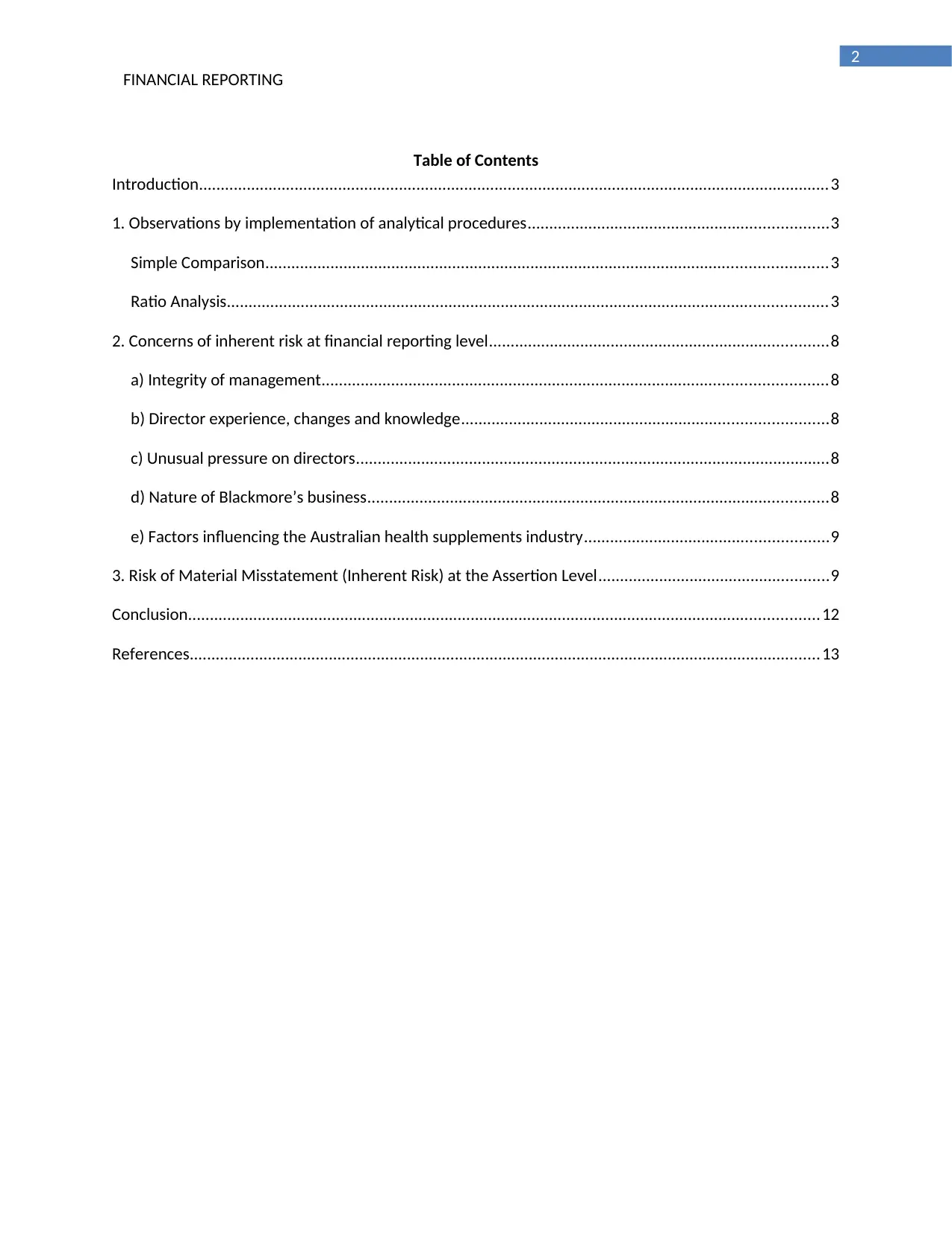
2
FINANCIAL REPORTING
Table of Contents
Introduction.................................................................................................................................................3
1. Observations by implementation of analytical procedures.....................................................................3
Simple Comparison.................................................................................................................................3
Ratio Analysis..........................................................................................................................................3
2. Concerns of inherent risk at financial reporting level..............................................................................8
a) Integrity of management....................................................................................................................8
b) Director experience, changes and knowledge....................................................................................8
c) Unusual pressure on directors.............................................................................................................8
d) Nature of Blackmore’s business..........................................................................................................8
e) Factors influencing the Australian health supplements industry........................................................9
3. Risk of Material Misstatement (Inherent Risk) at the Assertion Level.....................................................9
Conclusion.................................................................................................................................................12
References.................................................................................................................................................13
FINANCIAL REPORTING
Table of Contents
Introduction.................................................................................................................................................3
1. Observations by implementation of analytical procedures.....................................................................3
Simple Comparison.................................................................................................................................3
Ratio Analysis..........................................................................................................................................3
2. Concerns of inherent risk at financial reporting level..............................................................................8
a) Integrity of management....................................................................................................................8
b) Director experience, changes and knowledge....................................................................................8
c) Unusual pressure on directors.............................................................................................................8
d) Nature of Blackmore’s business..........................................................................................................8
e) Factors influencing the Australian health supplements industry........................................................9
3. Risk of Material Misstatement (Inherent Risk) at the Assertion Level.....................................................9
Conclusion.................................................................................................................................................12
References.................................................................................................................................................13
⊘ This is a preview!⊘
Do you want full access?
Subscribe today to unlock all pages.

Trusted by 1+ million students worldwide

3
FINANCIAL REPORTING
Introduction
The study is segregated into three section. The first excerpt aims to apply different types of
analytical procedures implemented by Blackmores Limited using ratio analysis for the last three years by
using annual report published in 2018, 2016 and 2017 respectively. The overall depictions are stated
how the analytical assessment will influence decisions pertaining to audit plan for the latest financial
year. The second part of the study has identified the risk of material misstatement or the different types
of inherent risk present at financial reporting level for Blackmore’s limited. This section of the study has
discussed about the inherent risk with five factors namely integrity of management, unusual pressure,
experience of management, business entities nature and factors influencing the industry in which the
entity operates. The latter part of the study has shown a significant risk pertaining to material
misstatement. This portion of the study has been further identified with the reasons why the account
balance of the companies is at significant risk for material misstatement, he assertions for non-validity of
risks, substantive audit procedure and application of practical internal control to mitigate such risks
(Louwers et al., 2015).
1. Observations by implementation of analytical procedures
Simple Comparison
Based on the assertions of balances pertaining to total assets and total liabilities in the last three
years it can be observed that Blackmore’s limited have shown a linear growth in terms of total assets.
However, there is also a subsequent increase in the total liabilities of the company. Henceforth this
fluctuation in the balances will have a negative repercussion on audit assessment (Chen, Srinidhi & Su,
2014).
Ratio Analysis
The comparison of the results with analytical procedures using ratios is identified with including
profitability ratios, liquidity ratios, financial leverage ratio, efficiency ratio and market value ratio.
Profitability Ratios:
Particulars 2018 2017 2016
$M $M $M
Profit for the year A 69223.0 58028.0
100020.
0
FINANCIAL REPORTING
Introduction
The study is segregated into three section. The first excerpt aims to apply different types of
analytical procedures implemented by Blackmores Limited using ratio analysis for the last three years by
using annual report published in 2018, 2016 and 2017 respectively. The overall depictions are stated
how the analytical assessment will influence decisions pertaining to audit plan for the latest financial
year. The second part of the study has identified the risk of material misstatement or the different types
of inherent risk present at financial reporting level for Blackmore’s limited. This section of the study has
discussed about the inherent risk with five factors namely integrity of management, unusual pressure,
experience of management, business entities nature and factors influencing the industry in which the
entity operates. The latter part of the study has shown a significant risk pertaining to material
misstatement. This portion of the study has been further identified with the reasons why the account
balance of the companies is at significant risk for material misstatement, he assertions for non-validity of
risks, substantive audit procedure and application of practical internal control to mitigate such risks
(Louwers et al., 2015).
1. Observations by implementation of analytical procedures
Simple Comparison
Based on the assertions of balances pertaining to total assets and total liabilities in the last three
years it can be observed that Blackmore’s limited have shown a linear growth in terms of total assets.
However, there is also a subsequent increase in the total liabilities of the company. Henceforth this
fluctuation in the balances will have a negative repercussion on audit assessment (Chen, Srinidhi & Su,
2014).
Ratio Analysis
The comparison of the results with analytical procedures using ratios is identified with including
profitability ratios, liquidity ratios, financial leverage ratio, efficiency ratio and market value ratio.
Profitability Ratios:
Particulars 2018 2017 2016
$M $M $M
Profit for the year A 69223.0 58028.0
100020.
0
Paraphrase This Document
Need a fresh take? Get an instant paraphrase of this document with our AI Paraphraser
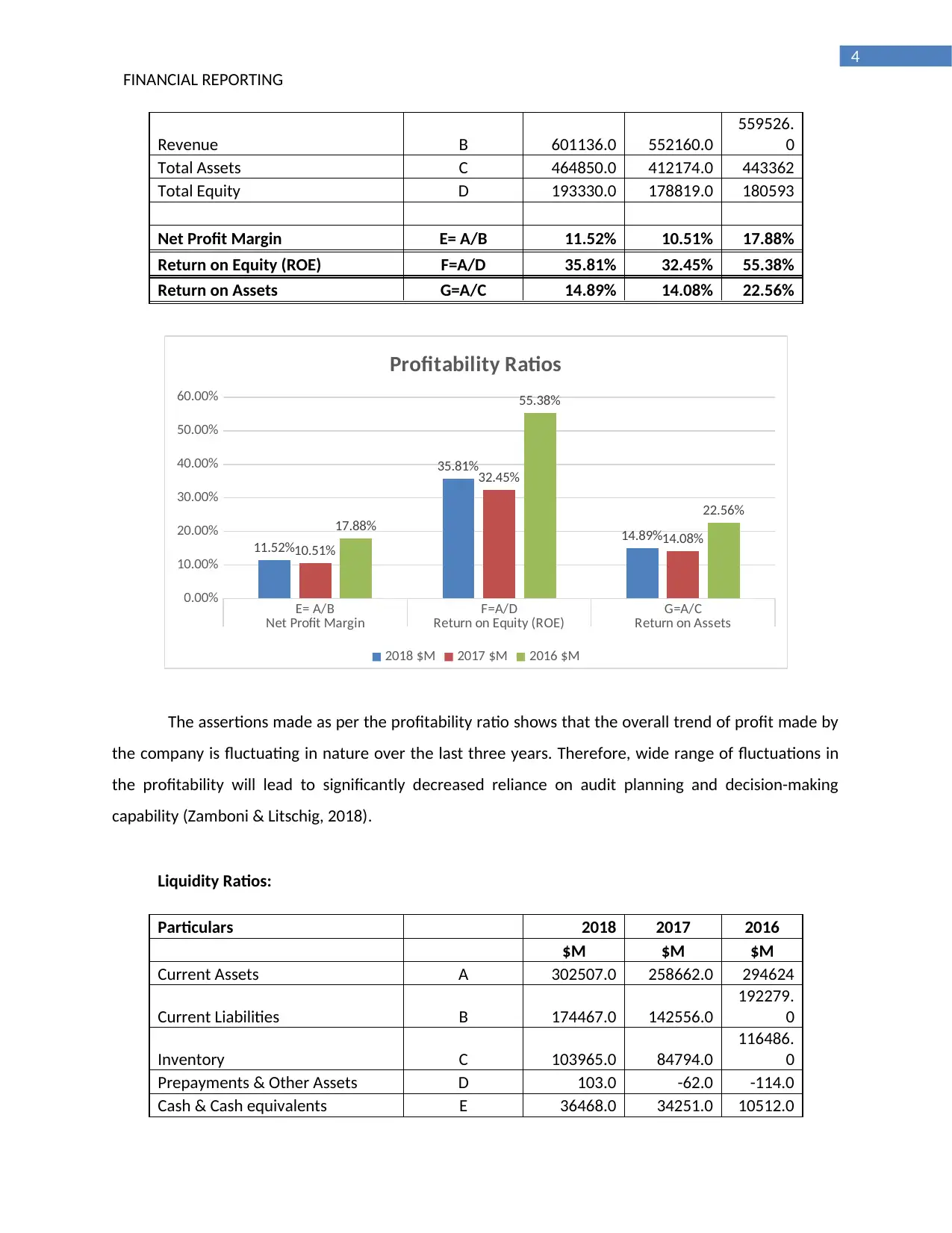
4
FINANCIAL REPORTING
Revenue B 601136.0 552160.0
559526.
0
Total Assets C 464850.0 412174.0 443362
Total Equity D 193330.0 178819.0 180593
Net Profit Margin E= A/B 11.52% 10.51% 17.88%
Return on Equity (ROE) F=A/D 35.81% 32.45% 55.38%
Return on Assets G=A/C 14.89% 14.08% 22.56%
E= A/B F=A/D G=A/C
Net Profit Margin Return on Equity (ROE) Return on Assets
0.00%
10.00%
20.00%
30.00%
40.00%
50.00%
60.00%
11.52%
35.81%
14.89%
10.51%
32.45%
14.08%
17.88%
55.38%
22.56%
Profitability Ratios
2018 $M 2017 $M 2016 $M
The assertions made as per the profitability ratio shows that the overall trend of profit made by
the company is fluctuating in nature over the last three years. Therefore, wide range of fluctuations in
the profitability will lead to significantly decreased reliance on audit planning and decision-making
capability (Zamboni & Litschig, 2018).
Liquidity Ratios:
Particulars 2018 2017 2016
$M $M $M
Current Assets A 302507.0 258662.0 294624
Current Liabilities B 174467.0 142556.0
192279.
0
Inventory C 103965.0 84794.0
116486.
0
Prepayments & Other Assets D 103.0 -62.0 -114.0
Cash & Cash equivalents E 36468.0 34251.0 10512.0
FINANCIAL REPORTING
Revenue B 601136.0 552160.0
559526.
0
Total Assets C 464850.0 412174.0 443362
Total Equity D 193330.0 178819.0 180593
Net Profit Margin E= A/B 11.52% 10.51% 17.88%
Return on Equity (ROE) F=A/D 35.81% 32.45% 55.38%
Return on Assets G=A/C 14.89% 14.08% 22.56%
E= A/B F=A/D G=A/C
Net Profit Margin Return on Equity (ROE) Return on Assets
0.00%
10.00%
20.00%
30.00%
40.00%
50.00%
60.00%
11.52%
35.81%
14.89%
10.51%
32.45%
14.08%
17.88%
55.38%
22.56%
Profitability Ratios
2018 $M 2017 $M 2016 $M
The assertions made as per the profitability ratio shows that the overall trend of profit made by
the company is fluctuating in nature over the last three years. Therefore, wide range of fluctuations in
the profitability will lead to significantly decreased reliance on audit planning and decision-making
capability (Zamboni & Litschig, 2018).
Liquidity Ratios:
Particulars 2018 2017 2016
$M $M $M
Current Assets A 302507.0 258662.0 294624
Current Liabilities B 174467.0 142556.0
192279.
0
Inventory C 103965.0 84794.0
116486.
0
Prepayments & Other Assets D 103.0 -62.0 -114.0
Cash & Cash equivalents E 36468.0 34251.0 10512.0

5
FINANCIAL REPORTING
Current Ratio F=A/B 1.73 1.81 1.53
Quick Ratio G=(A-C-D)/B 1.14 1.22 0.93
Cash Ratio H=E/B 0.21 0.24 0.05
F=A/B G=(A-C-D)/B H=E/B
Current Ratio Quick Ratio Cash Ratio
0.00
0.20
0.40
0.60
0.80
1.00
1.20
1.40
1.60
1.80
2.00
1.73
1.14
0.21
1.81
1.22
0.24
1.53
0.93
0.05
Liquidity Ratios
2018 $M 2017 $M 2016 $M
The important depictions as per the liquidity ratio is depicted with an increasing trend among
Cash ratio, quick ratio and current ratio. Therefore, it is evident that Blackmore’s limited is consistent in
increasing its cash for operating activities. This will have a positive impact on audit assertions.
Financial Leverage Ratio:
Particulars 2018 2017 2016
$M $M $M
Total Assets A 464850.0 412174.0
443362.
0
Total Equity B 193330.0 178819.0
180593.
0
Total Liabilities C 271520.0 233355.0
262769.
0
Debt-to-Equity Ratio D=C/B 1.40 1.30 1.46
Debt Ratio E=C/A 0.584 0.566 0.593
Equity Ratio F=B/A 0.416 0.434 0.407
FINANCIAL REPORTING
Current Ratio F=A/B 1.73 1.81 1.53
Quick Ratio G=(A-C-D)/B 1.14 1.22 0.93
Cash Ratio H=E/B 0.21 0.24 0.05
F=A/B G=(A-C-D)/B H=E/B
Current Ratio Quick Ratio Cash Ratio
0.00
0.20
0.40
0.60
0.80
1.00
1.20
1.40
1.60
1.80
2.00
1.73
1.14
0.21
1.81
1.22
0.24
1.53
0.93
0.05
Liquidity Ratios
2018 $M 2017 $M 2016 $M
The important depictions as per the liquidity ratio is depicted with an increasing trend among
Cash ratio, quick ratio and current ratio. Therefore, it is evident that Blackmore’s limited is consistent in
increasing its cash for operating activities. This will have a positive impact on audit assertions.
Financial Leverage Ratio:
Particulars 2018 2017 2016
$M $M $M
Total Assets A 464850.0 412174.0
443362.
0
Total Equity B 193330.0 178819.0
180593.
0
Total Liabilities C 271520.0 233355.0
262769.
0
Debt-to-Equity Ratio D=C/B 1.40 1.30 1.46
Debt Ratio E=C/A 0.584 0.566 0.593
Equity Ratio F=B/A 0.416 0.434 0.407
⊘ This is a preview!⊘
Do you want full access?
Subscribe today to unlock all pages.

Trusted by 1+ million students worldwide

6
FINANCIAL REPORTING
D=C/B E=C/A F=B/A
Debt-to-Equity Ratio Debt Ratio Equity Ratio
0.00
0.20
0.40
0.60
0.80
1.00
1.20
1.40
1.60 1.404
0.584
0.416
1.305
0.566
0.434
1.455
0.593
0.407
Financial Leverage Ratio
2018 $M 2017 $M 2016 $M
The evaluation of information as per financial leverage ratio clearly identifies that over the years
company has not been able to reduce its dependency on long-term borrowings. This will have a greater
divergence among investors assessment and lead to negative repercussions on auditing (Park et al.,
2015).
Efficiency Ratio:
Particulars` 2018 2017 2016
$M $M $M
Total Assets A 464850.0 412174.0
443362.
0
Fixed Assets B 76261.0 74207.0 66126.0
Revenue C 601136.0 552160.0
559526.
0
Trade & Other Receivables D 150788.0 132146.0
129554.
0
Total Asset Turnover Ratio E=C/A 1.29 1.34 1.26
Fixed Asset Turnover Ratio F=C/B 7.88 7.44 8.46
Receivables Turnover Ratio G=C/D 25.08% 23.93% 23.15%
FINANCIAL REPORTING
D=C/B E=C/A F=B/A
Debt-to-Equity Ratio Debt Ratio Equity Ratio
0.00
0.20
0.40
0.60
0.80
1.00
1.20
1.40
1.60 1.404
0.584
0.416
1.305
0.566
0.434
1.455
0.593
0.407
Financial Leverage Ratio
2018 $M 2017 $M 2016 $M
The evaluation of information as per financial leverage ratio clearly identifies that over the years
company has not been able to reduce its dependency on long-term borrowings. This will have a greater
divergence among investors assessment and lead to negative repercussions on auditing (Park et al.,
2015).
Efficiency Ratio:
Particulars` 2018 2017 2016
$M $M $M
Total Assets A 464850.0 412174.0
443362.
0
Fixed Assets B 76261.0 74207.0 66126.0
Revenue C 601136.0 552160.0
559526.
0
Trade & Other Receivables D 150788.0 132146.0
129554.
0
Total Asset Turnover Ratio E=C/A 1.29 1.34 1.26
Fixed Asset Turnover Ratio F=C/B 7.88 7.44 8.46
Receivables Turnover Ratio G=C/D 25.08% 23.93% 23.15%
Paraphrase This Document
Need a fresh take? Get an instant paraphrase of this document with our AI Paraphraser
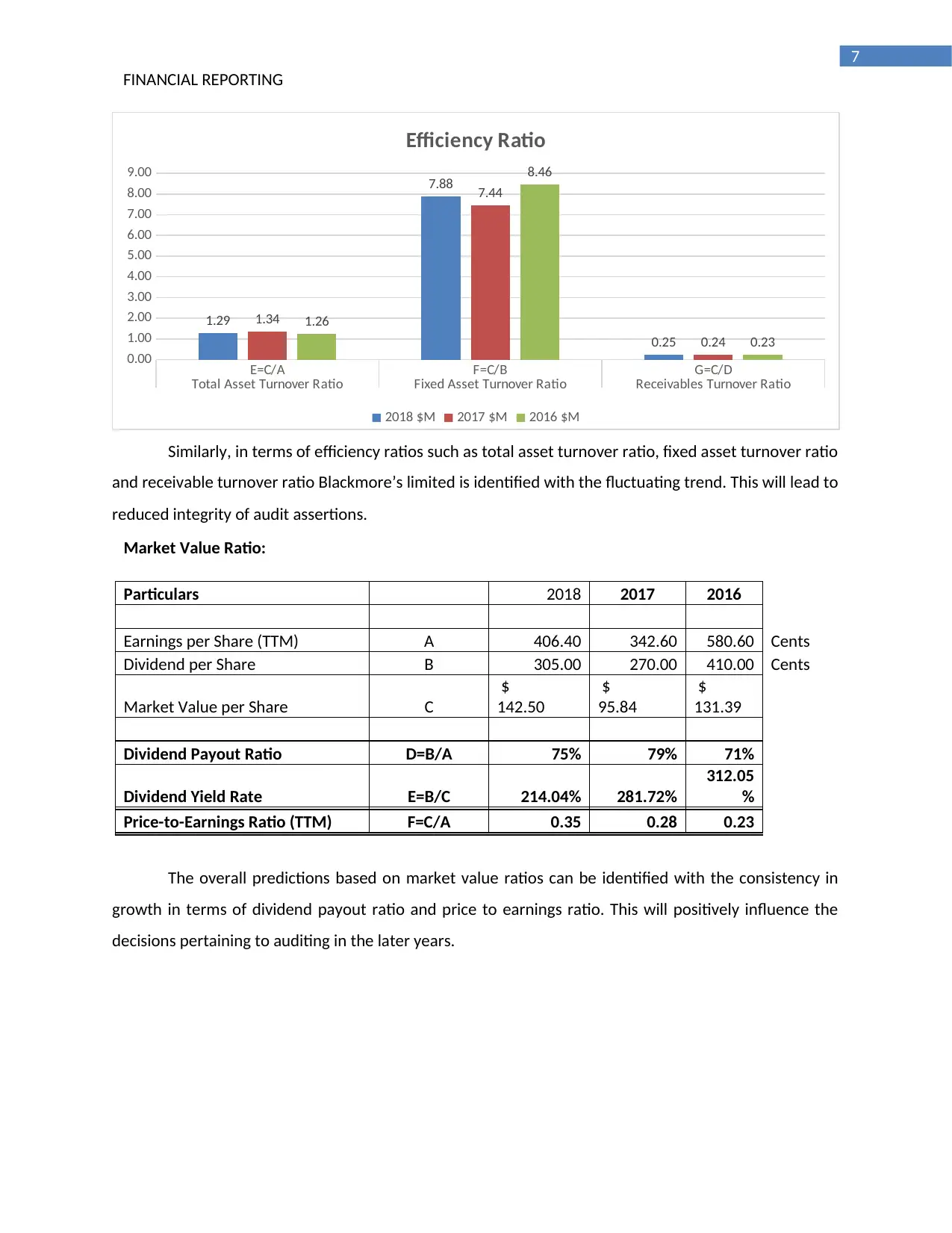
7
FINANCIAL REPORTING
E=C/A F=C/B G=C/D
Total Asset Turnover Ratio Fixed Asset Turnover Ratio Receivables Turnover Ratio
0.00
1.00
2.00
3.00
4.00
5.00
6.00
7.00
8.00
9.00
1.29
7.88
0.25
1.34
7.44
0.24
1.26
8.46
0.23
Efficiency Ratio
2018 $M 2017 $M 2016 $M
Similarly, in terms of efficiency ratios such as total asset turnover ratio, fixed asset turnover ratio
and receivable turnover ratio Blackmore’s limited is identified with the fluctuating trend. This will lead to
reduced integrity of audit assertions.
Market Value Ratio:
Particulars 2018 2017 2016
Earnings per Share (TTM) A 406.40 342.60 580.60 Cents
Dividend per Share B 305.00 270.00 410.00 Cents
Market Value per Share C
$
142.50
$
95.84
$
131.39
Dividend Payout Ratio D=B/A 75% 79% 71%
Dividend Yield Rate E=B/C 214.04% 281.72%
312.05
%
Price-to-Earnings Ratio (TTM) F=C/A 0.35 0.28 0.23
The overall predictions based on market value ratios can be identified with the consistency in
growth in terms of dividend payout ratio and price to earnings ratio. This will positively influence the
decisions pertaining to auditing in the later years.
FINANCIAL REPORTING
E=C/A F=C/B G=C/D
Total Asset Turnover Ratio Fixed Asset Turnover Ratio Receivables Turnover Ratio
0.00
1.00
2.00
3.00
4.00
5.00
6.00
7.00
8.00
9.00
1.29
7.88
0.25
1.34
7.44
0.24
1.26
8.46
0.23
Efficiency Ratio
2018 $M 2017 $M 2016 $M
Similarly, in terms of efficiency ratios such as total asset turnover ratio, fixed asset turnover ratio
and receivable turnover ratio Blackmore’s limited is identified with the fluctuating trend. This will lead to
reduced integrity of audit assertions.
Market Value Ratio:
Particulars 2018 2017 2016
Earnings per Share (TTM) A 406.40 342.60 580.60 Cents
Dividend per Share B 305.00 270.00 410.00 Cents
Market Value per Share C
$
142.50
$
95.84
$
131.39
Dividend Payout Ratio D=B/A 75% 79% 71%
Dividend Yield Rate E=B/C 214.04% 281.72%
312.05
%
Price-to-Earnings Ratio (TTM) F=C/A 0.35 0.28 0.23
The overall predictions based on market value ratios can be identified with the consistency in
growth in terms of dividend payout ratio and price to earnings ratio. This will positively influence the
decisions pertaining to auditing in the later years.
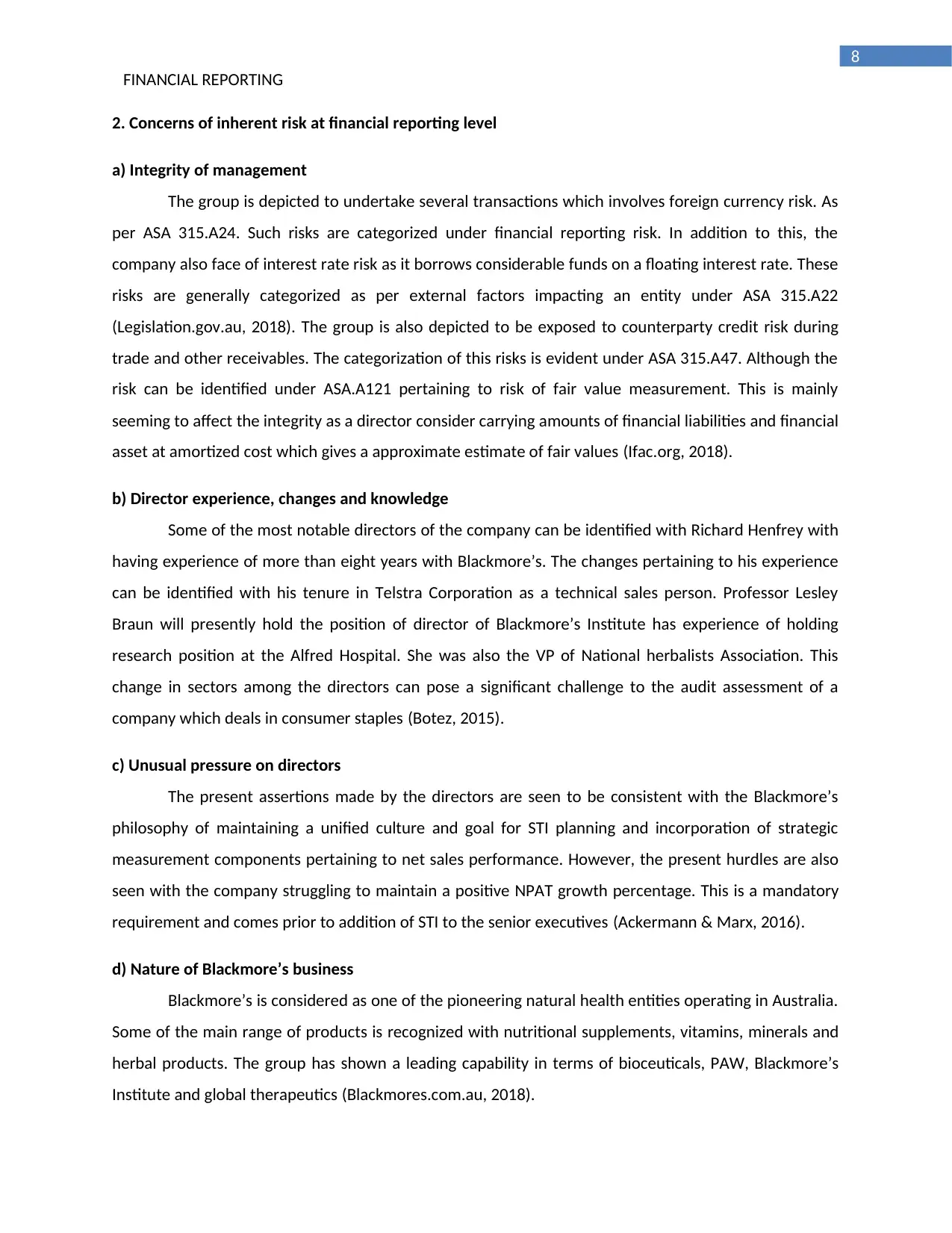
8
FINANCIAL REPORTING
2. Concerns of inherent risk at financial reporting level
a) Integrity of management
The group is depicted to undertake several transactions which involves foreign currency risk. As
per ASA 315.A24. Such risks are categorized under financial reporting risk. In addition to this, the
company also face of interest rate risk as it borrows considerable funds on a floating interest rate. These
risks are generally categorized as per external factors impacting an entity under ASA 315.A22
(Legislation.gov.au, 2018). The group is also depicted to be exposed to counterparty credit risk during
trade and other receivables. The categorization of this risks is evident under ASA 315.A47. Although the
risk can be identified under ASA.A121 pertaining to risk of fair value measurement. This is mainly
seeming to affect the integrity as a director consider carrying amounts of financial liabilities and financial
asset at amortized cost which gives a approximate estimate of fair values (Ifac.org, 2018).
b) Director experience, changes and knowledge
Some of the most notable directors of the company can be identified with Richard Henfrey with
having experience of more than eight years with Blackmore’s. The changes pertaining to his experience
can be identified with his tenure in Telstra Corporation as a technical sales person. Professor Lesley
Braun will presently hold the position of director of Blackmore’s Institute has experience of holding
research position at the Alfred Hospital. She was also the VP of National herbalists Association. This
change in sectors among the directors can pose a significant challenge to the audit assessment of a
company which deals in consumer staples (Botez, 2015).
c) Unusual pressure on directors
The present assertions made by the directors are seen to be consistent with the Blackmore’s
philosophy of maintaining a unified culture and goal for STI planning and incorporation of strategic
measurement components pertaining to net sales performance. However, the present hurdles are also
seen with the company struggling to maintain a positive NPAT growth percentage. This is a mandatory
requirement and comes prior to addition of STI to the senior executives (Ackermann & Marx, 2016).
d) Nature of Blackmore’s business
Blackmore’s is considered as one of the pioneering natural health entities operating in Australia.
Some of the main range of products is recognized with nutritional supplements, vitamins, minerals and
herbal products. The group has shown a leading capability in terms of bioceuticals, PAW, Blackmore’s
Institute and global therapeutics (Blackmores.com.au, 2018).
FINANCIAL REPORTING
2. Concerns of inherent risk at financial reporting level
a) Integrity of management
The group is depicted to undertake several transactions which involves foreign currency risk. As
per ASA 315.A24. Such risks are categorized under financial reporting risk. In addition to this, the
company also face of interest rate risk as it borrows considerable funds on a floating interest rate. These
risks are generally categorized as per external factors impacting an entity under ASA 315.A22
(Legislation.gov.au, 2018). The group is also depicted to be exposed to counterparty credit risk during
trade and other receivables. The categorization of this risks is evident under ASA 315.A47. Although the
risk can be identified under ASA.A121 pertaining to risk of fair value measurement. This is mainly
seeming to affect the integrity as a director consider carrying amounts of financial liabilities and financial
asset at amortized cost which gives a approximate estimate of fair values (Ifac.org, 2018).
b) Director experience, changes and knowledge
Some of the most notable directors of the company can be identified with Richard Henfrey with
having experience of more than eight years with Blackmore’s. The changes pertaining to his experience
can be identified with his tenure in Telstra Corporation as a technical sales person. Professor Lesley
Braun will presently hold the position of director of Blackmore’s Institute has experience of holding
research position at the Alfred Hospital. She was also the VP of National herbalists Association. This
change in sectors among the directors can pose a significant challenge to the audit assessment of a
company which deals in consumer staples (Botez, 2015).
c) Unusual pressure on directors
The present assertions made by the directors are seen to be consistent with the Blackmore’s
philosophy of maintaining a unified culture and goal for STI planning and incorporation of strategic
measurement components pertaining to net sales performance. However, the present hurdles are also
seen with the company struggling to maintain a positive NPAT growth percentage. This is a mandatory
requirement and comes prior to addition of STI to the senior executives (Ackermann & Marx, 2016).
d) Nature of Blackmore’s business
Blackmore’s is considered as one of the pioneering natural health entities operating in Australia.
Some of the main range of products is recognized with nutritional supplements, vitamins, minerals and
herbal products. The group has shown a leading capability in terms of bioceuticals, PAW, Blackmore’s
Institute and global therapeutics (Blackmores.com.au, 2018).
⊘ This is a preview!⊘
Do you want full access?
Subscribe today to unlock all pages.

Trusted by 1+ million students worldwide
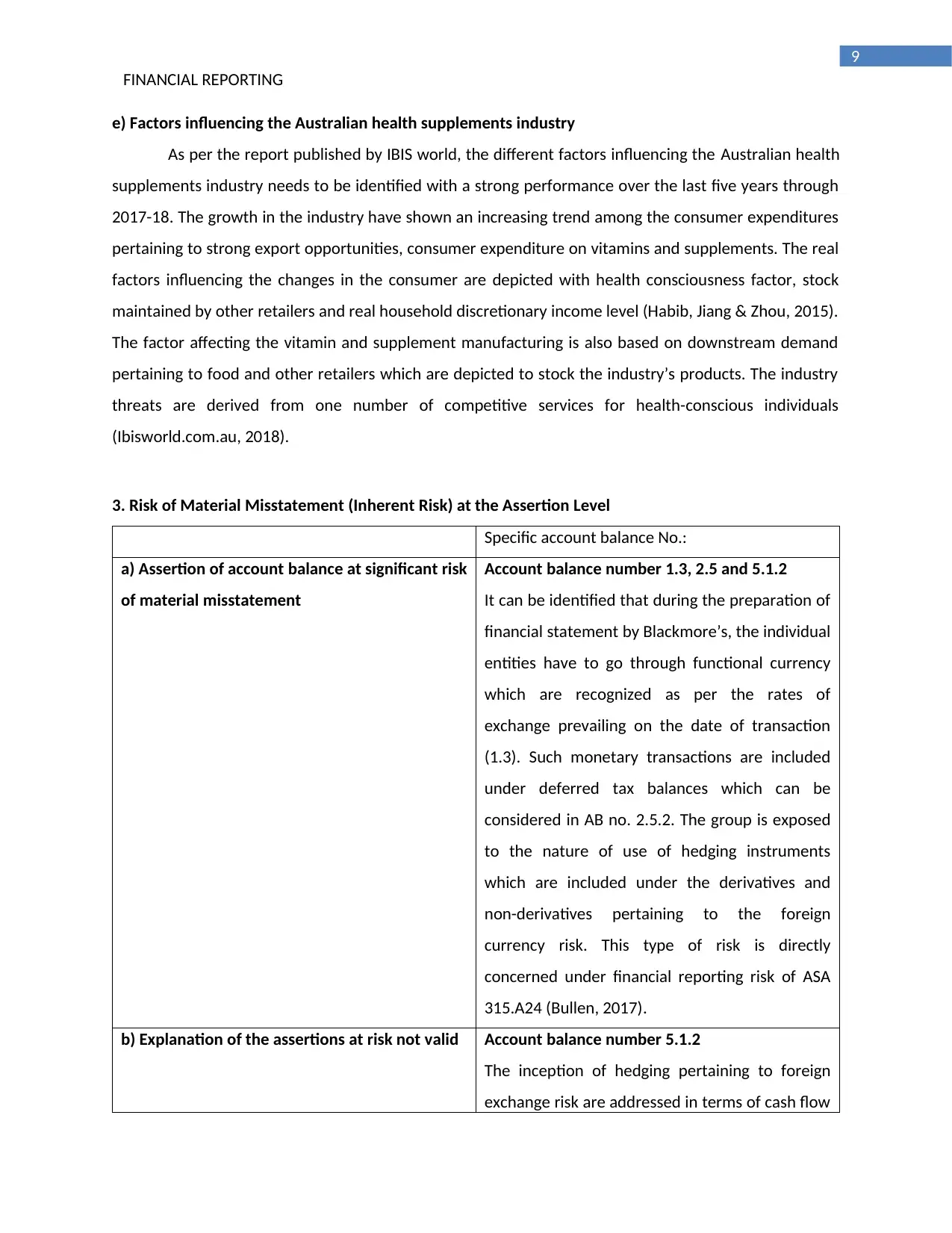
9
FINANCIAL REPORTING
e) Factors influencing the Australian health supplements industry
As per the report published by IBIS world, the different factors influencing the Australian health
supplements industry needs to be identified with a strong performance over the last five years through
2017-18. The growth in the industry have shown an increasing trend among the consumer expenditures
pertaining to strong export opportunities, consumer expenditure on vitamins and supplements. The real
factors influencing the changes in the consumer are depicted with health consciousness factor, stock
maintained by other retailers and real household discretionary income level (Habib, Jiang & Zhou, 2015).
The factor affecting the vitamin and supplement manufacturing is also based on downstream demand
pertaining to food and other retailers which are depicted to stock the industry’s products. The industry
threats are derived from one number of competitive services for health-conscious individuals
(Ibisworld.com.au, 2018).
3. Risk of Material Misstatement (Inherent Risk) at the Assertion Level
Specific account balance No.:
a) Assertion of account balance at significant risk
of material misstatement
Account balance number 1.3, 2.5 and 5.1.2
It can be identified that during the preparation of
financial statement by Blackmore’s, the individual
entities have to go through functional currency
which are recognized as per the rates of
exchange prevailing on the date of transaction
(1.3). Such monetary transactions are included
under deferred tax balances which can be
considered in AB no. 2.5.2. The group is exposed
to the nature of use of hedging instruments
which are included under the derivatives and
non-derivatives pertaining to the foreign
currency risk. This type of risk is directly
concerned under financial reporting risk of ASA
315.A24 (Bullen, 2017).
b) Explanation of the assertions at risk not valid Account balance number 5.1.2
The inception of hedging pertaining to foreign
exchange risk are addressed in terms of cash flow
FINANCIAL REPORTING
e) Factors influencing the Australian health supplements industry
As per the report published by IBIS world, the different factors influencing the Australian health
supplements industry needs to be identified with a strong performance over the last five years through
2017-18. The growth in the industry have shown an increasing trend among the consumer expenditures
pertaining to strong export opportunities, consumer expenditure on vitamins and supplements. The real
factors influencing the changes in the consumer are depicted with health consciousness factor, stock
maintained by other retailers and real household discretionary income level (Habib, Jiang & Zhou, 2015).
The factor affecting the vitamin and supplement manufacturing is also based on downstream demand
pertaining to food and other retailers which are depicted to stock the industry’s products. The industry
threats are derived from one number of competitive services for health-conscious individuals
(Ibisworld.com.au, 2018).
3. Risk of Material Misstatement (Inherent Risk) at the Assertion Level
Specific account balance No.:
a) Assertion of account balance at significant risk
of material misstatement
Account balance number 1.3, 2.5 and 5.1.2
It can be identified that during the preparation of
financial statement by Blackmore’s, the individual
entities have to go through functional currency
which are recognized as per the rates of
exchange prevailing on the date of transaction
(1.3). Such monetary transactions are included
under deferred tax balances which can be
considered in AB no. 2.5.2. The group is exposed
to the nature of use of hedging instruments
which are included under the derivatives and
non-derivatives pertaining to the foreign
currency risk. This type of risk is directly
concerned under financial reporting risk of ASA
315.A24 (Bullen, 2017).
b) Explanation of the assertions at risk not valid Account balance number 5.1.2
The inception of hedging pertaining to foreign
exchange risk are addressed in terms of cash flow
Paraphrase This Document
Need a fresh take? Get an instant paraphrase of this document with our AI Paraphraser

10
FINANCIAL REPORTING
hedges. The initiation of this relationship
pertaining to the documents of the entities are
seen to be maintained by following an
appropriate ongoing derivative which are highly
effective for offsetting the changes pertaining to
fair values and cash flows from the hedged items.
c) Detailed report on relevant substantive audit
procedure for accessing assertion at risk
Account balance number 5.3
The substantive audit procedure for managing
risk pertaining to exchange rate exposures can be
depicted in terms of approving a particular policy
parameter by using forward exchange contracts.
The issue of forward exchange contracts will be
set to increase or decrease the Australian dollar
value against the relevant foreign currency
(Griffiths, 2016).
d) Detailed report on practical internal control
to mitigate the risk of audit assertion
Account balance number 5.4
The detailed report on maintaining the interest
rate risk is identified with use of SWAP contracts
for interest rates. The risk management for credit
sources is determined with analyzing the credit
worthiness of a supply which is recorded under
independent rating agencies (Collins, Xie & Zhu,
2015). In addition to this, the liquidity risk of the
company is undertaken by working on various
types of short-term and medium-term funding
requirements for liquidity. These are particularly
evident with initiatives such as maintaining of
adequate banking facilities and continual
monitoring of cash flow forecasts (Graham,
Bedard & Dutta, 2018).
FINANCIAL REPORTING
hedges. The initiation of this relationship
pertaining to the documents of the entities are
seen to be maintained by following an
appropriate ongoing derivative which are highly
effective for offsetting the changes pertaining to
fair values and cash flows from the hedged items.
c) Detailed report on relevant substantive audit
procedure for accessing assertion at risk
Account balance number 5.3
The substantive audit procedure for managing
risk pertaining to exchange rate exposures can be
depicted in terms of approving a particular policy
parameter by using forward exchange contracts.
The issue of forward exchange contracts will be
set to increase or decrease the Australian dollar
value against the relevant foreign currency
(Griffiths, 2016).
d) Detailed report on practical internal control
to mitigate the risk of audit assertion
Account balance number 5.4
The detailed report on maintaining the interest
rate risk is identified with use of SWAP contracts
for interest rates. The risk management for credit
sources is determined with analyzing the credit
worthiness of a supply which is recorded under
independent rating agencies (Collins, Xie & Zhu,
2015). In addition to this, the liquidity risk of the
company is undertaken by working on various
types of short-term and medium-term funding
requirements for liquidity. These are particularly
evident with initiatives such as maintaining of
adequate banking facilities and continual
monitoring of cash flow forecasts (Graham,
Bedard & Dutta, 2018).
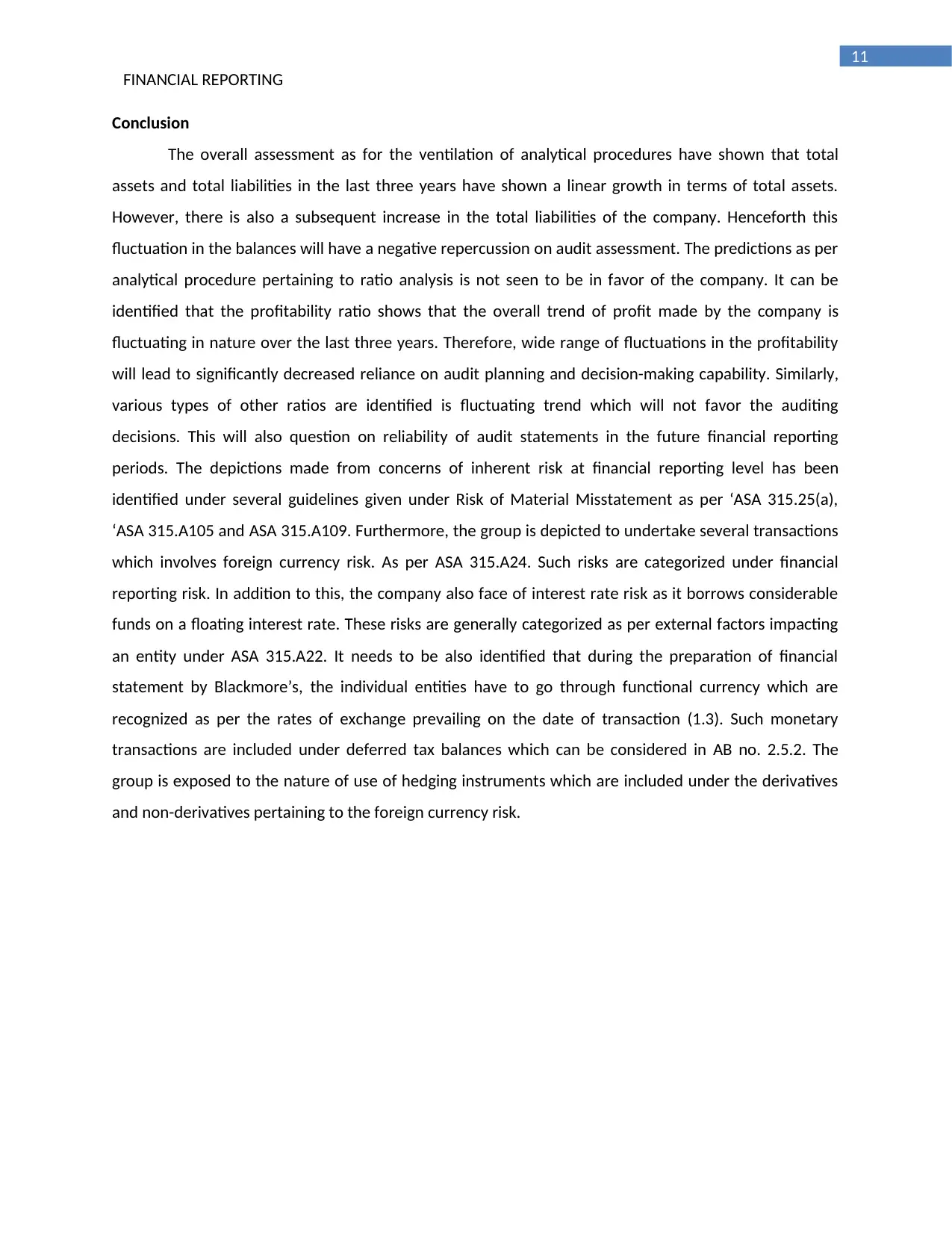
11
FINANCIAL REPORTING
Conclusion
The overall assessment as for the ventilation of analytical procedures have shown that total
assets and total liabilities in the last three years have shown a linear growth in terms of total assets.
However, there is also a subsequent increase in the total liabilities of the company. Henceforth this
fluctuation in the balances will have a negative repercussion on audit assessment. The predictions as per
analytical procedure pertaining to ratio analysis is not seen to be in favor of the company. It can be
identified that the profitability ratio shows that the overall trend of profit made by the company is
fluctuating in nature over the last three years. Therefore, wide range of fluctuations in the profitability
will lead to significantly decreased reliance on audit planning and decision-making capability. Similarly,
various types of other ratios are identified is fluctuating trend which will not favor the auditing
decisions. This will also question on reliability of audit statements in the future financial reporting
periods. The depictions made from concerns of inherent risk at financial reporting level has been
identified under several guidelines given under Risk of Material Misstatement as per ‘ASA 315.25(a),
‘ASA 315.A105 and ASA 315.A109. Furthermore, the group is depicted to undertake several transactions
which involves foreign currency risk. As per ASA 315.A24. Such risks are categorized under financial
reporting risk. In addition to this, the company also face of interest rate risk as it borrows considerable
funds on a floating interest rate. These risks are generally categorized as per external factors impacting
an entity under ASA 315.A22. It needs to be also identified that during the preparation of financial
statement by Blackmore’s, the individual entities have to go through functional currency which are
recognized as per the rates of exchange prevailing on the date of transaction (1.3). Such monetary
transactions are included under deferred tax balances which can be considered in AB no. 2.5.2. The
group is exposed to the nature of use of hedging instruments which are included under the derivatives
and non-derivatives pertaining to the foreign currency risk.
FINANCIAL REPORTING
Conclusion
The overall assessment as for the ventilation of analytical procedures have shown that total
assets and total liabilities in the last three years have shown a linear growth in terms of total assets.
However, there is also a subsequent increase in the total liabilities of the company. Henceforth this
fluctuation in the balances will have a negative repercussion on audit assessment. The predictions as per
analytical procedure pertaining to ratio analysis is not seen to be in favor of the company. It can be
identified that the profitability ratio shows that the overall trend of profit made by the company is
fluctuating in nature over the last three years. Therefore, wide range of fluctuations in the profitability
will lead to significantly decreased reliance on audit planning and decision-making capability. Similarly,
various types of other ratios are identified is fluctuating trend which will not favor the auditing
decisions. This will also question on reliability of audit statements in the future financial reporting
periods. The depictions made from concerns of inherent risk at financial reporting level has been
identified under several guidelines given under Risk of Material Misstatement as per ‘ASA 315.25(a),
‘ASA 315.A105 and ASA 315.A109. Furthermore, the group is depicted to undertake several transactions
which involves foreign currency risk. As per ASA 315.A24. Such risks are categorized under financial
reporting risk. In addition to this, the company also face of interest rate risk as it borrows considerable
funds on a floating interest rate. These risks are generally categorized as per external factors impacting
an entity under ASA 315.A22. It needs to be also identified that during the preparation of financial
statement by Blackmore’s, the individual entities have to go through functional currency which are
recognized as per the rates of exchange prevailing on the date of transaction (1.3). Such monetary
transactions are included under deferred tax balances which can be considered in AB no. 2.5.2. The
group is exposed to the nature of use of hedging instruments which are included under the derivatives
and non-derivatives pertaining to the foreign currency risk.
⊘ This is a preview!⊘
Do you want full access?
Subscribe today to unlock all pages.

Trusted by 1+ million students worldwide
1 out of 14
Related Documents
Your All-in-One AI-Powered Toolkit for Academic Success.
+13062052269
info@desklib.com
Available 24*7 on WhatsApp / Email
![[object Object]](/_next/static/media/star-bottom.7253800d.svg)
Unlock your academic potential
Copyright © 2020–2026 A2Z Services. All Rights Reserved. Developed and managed by ZUCOL.



